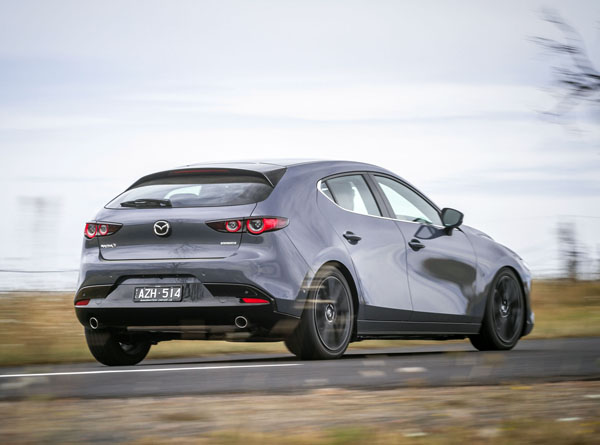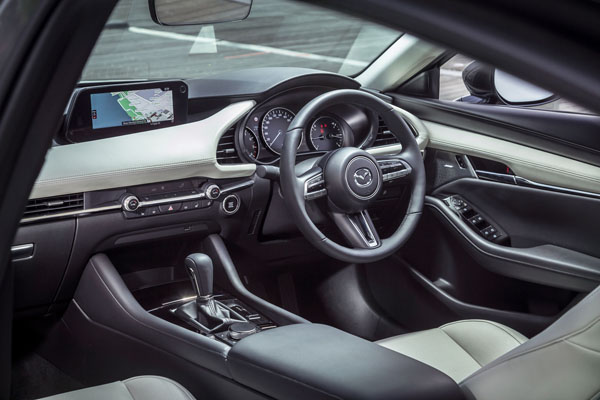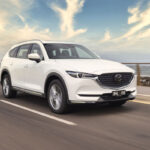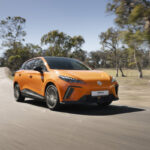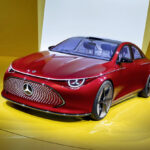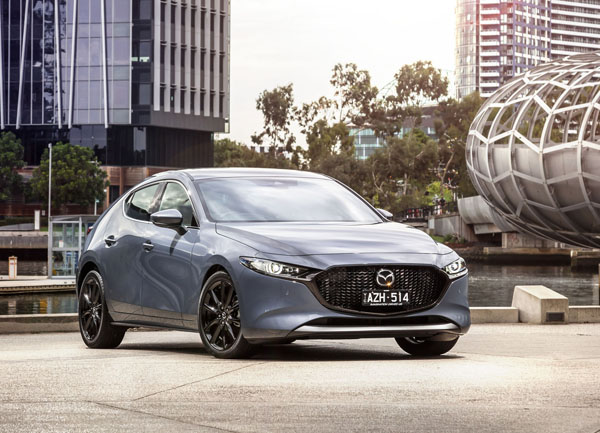
The name Astina might not be as old as the hills but the eponymous Mazda certainly goes back well into the past century; to 1963 in fact, when the small family car had its roots in the Familia.
Progressing through the Mazda 323 and Protege to the sixth generation in 1989 when the new five-door fastback version was called the Familia Astina in Japan and was sold as the 323F or 323 Astina elsewhere.
Thirty years later the Astina is still going strong as the top model of the Mazda3. The latest iteration, known as Next-Gen Mazda3, introduced to Australia in early this year in hatchback form, and joined by the sedan in May, presents a tantalising look into the future for the Japanese automobile manufacturer.
From entry-level Pure G20 – $24,990, plus on-road costs – through Evolve, Touring to GT variants, the G25 Astina, the test vehicle, maintains its position at the top of the class. It sells for $37,990.
Unique to the G25 Astina hatch are black finish 18-inch alloy wheels, 360 degree view monitor, adaptive LED headlights, cruising and traffic support, driver monitoring, front cross-traffic alert, front parking sensors, burgundy leather seats, smart brake support-rear crossing and sunroof.
STYLING
As someone said: “Simplicity is the keynote of good design,” which could be straight out of the Next-Gen Mazda3 playbook.
In keeping with Mazda’s Kodo philosophy, company creatives have forgone character lines and chrome, sticking with elegantly curved panels constantly changing how light is reflected from the moving car.
The nose of Next-Gen Mazda3 hatch has been lowered from the previous model to create greater visual flow and emphasise the beauty of the vehicle’s proportions. Lights take on the ‘less is more’ in design and produce a simple ring-shaped lighting pattern for the headlamps.
The wings are painted in a gloss black, the dark tone leaving the car like a broad shouldered, square-jawed comic book-style hero ready to do battle with the forces of automotive design evil.
INTERIOR
The minimalist approach extends to cabin design with a comfortable environment allowing the driver simply to get on with the job in comfort. A symmetrical horizontal layout of instruments and controls is minus unnecessary elements aimed at enhancing driving pleasure.
The vertical steering wheel spoke is narrower than the two horizontal spokes, and the right and left instrument faces of the three-meter cluster are angled inward to face the driver and easier to read.
While recognising climate control air-conditioning is easier to access if it is positioned high on the dashboard, designers recognised it should not be conspicuous. Here it is integrated into the instrument panel.
INFOTAINMENT
Next Gen Mazda3’s 7-inch, thin film transistor, liquid crystal display and easy-to-read gauges manages a variety of information, while the windscreen projected Active Driving Display gauges and centre display have all been redesigned.
An 8.8-inch wide centre infotainment display is operated exclusively through the Commander Control on the centre console, the display reproducing the Commander Control, suggesting how best to use it.
Mazda Connect has faster processing power, is more intuitive and adds Apple CarPlay and Android Auto. The audio is
ENGINES / TRANSMISSIONS
At present, with a choice of two four-cylinder petrol engines, designated G20 and G25, mated with either a six-speed manual or automatic. The revolutionary Mazda Skyactiv-X engine will be here before the end of 2019.
The 2.5-litre four-cylinder petrol engine of the G25 Astina is a step up from the G20 motor of the cheaper models.
With a high compression ratio of 13:1, performance of the 2.5-litre four-cylinder engine has been boosted from the previous generation to give a maximum power output of 139 kW at 6000 rpm and 252 Nm of torque at 4000 rpm. Like all Next-Gen automatics, the motor is mated with Mazda’s six-speed Skyactiv-Drive transmission.
SAFETY
Newly developed i-Activsense technologies debut on this Mazda3. These include driver monitoring, front cross traffic alert and cruising and traffic support, while existing systems have been further developed with the most advanced technologies available.
Passive safety has been enhanced with a higher percentage of high-tensile steel employed for the body, plus Next-Gen Mazda3 is the first Mazda to add a driver’s knee airbag joining front, side and side curtain airbags as standard equipment.
DRIVING
Settling into classy burgundy leather seats, puts occupants at ease, at the same time endowing them with something of a superior feeling. Responsibility for this is new seat design, which maintains the natural S-curve of the spine to achieve the ideal driving position.
When the ignition is switched off, the driver’s seat slides back to allow easier exit and entry from the cabin, sliding back into the driver’s ideal position when the ignition is switched on. The range of the telescopic steering wheel has been increased, adding to the driver’s wellbeing.
Rear occupants are not so lucky. Despite adequate head room for the average size person, the doors offer reduced height causing many adults to stoop dramatically to avoid bumping the noggin.
The cabin is quiet, being isolated from external, wind, traffic and tyre noise by the latest NVH technology, leaving only desirable sounds such as conversation and audio to dominate the space.
The 2.5-litre four-cylinder engine also goes about business with no annoying sounds emitted from under the bonnet. With Mazda’s stop / start engine technology and cylinder deactivation under light loads, fuel consumption on the combined urban / highway cycle is claimed by Mazda to be 6.6 litres per 100 kilometres.
The test vehicle hit the mark with 8.4 litres per 100 kilometres and 5.2 litres per 100 kilometres, respectively, under similar circumstances. Next-Gen Mazda3 debuts Skyactiv-Vehicle architecture, which has improved stability and handling exhibited over a range of driving conditions during the test period.
SUMMING UP
The Mazda3 Astina hatchback, over the years, has developed from a cute unassuming runabout to the Next-Gen high-tech, small-car class leader in looks it is today. With this in mind, plus a long list of comfort and convenience features introducing the future of Mazda, the 40-grand or so price on road does not appear excessive.
AT A GLANCE
MODEL LINE-UP
Mazda3 G20 Pure: $24,990 (manual), $25,990 (automatic)
Mazda3 G20 Evolve: $26,690 (manual), $27,690 (automatic)
Mazda3 G20 Touring: $28,990 (manual), $29,990 (automatic)
Mazda3 G25 Evolve: $29,490 (manual), $30,490 (automatic)
Mazda3 G25 GT: $33,490 (manual), $34,490 (automatic)
Mazda3 G25 Astina: $36,990 (manual), $37,990 (automatic)
Options:
Vision Technology $1500
Soul Red Crystal Metallic paint, Machine Grey Metallic paint, Polymetal Grey metallic paint $495
Note: These prices do not include dealer or government charges. Contact your local Mazda dealer for drive-away prices.
SPECIFICATIONS
(Mazda3 G25 Astina 2.5-litre petrol, 6sp automatic, 5dr hatch)
Capacity: 2488 cc
Configuration: 2.5-litre in-line 4-cylinder 16-valve DOHC S-VT petrol (Skyactiv-G) with i-stop and cylinder deactivation
Maximum Power: 139 kW @ 6000 rpm
Maximum Torque: 252 Nm @ 4000 rpm
Fuel type: Petrol 91 RON
Combined Cycle (ADR 81/01): 6.6 litres per 100 km
DRIVELINE:
Drivetrain: 6-speed Skyactiv-Drive automatic, FWD
DIMENSIONS, WEIGHT AND CAPACITIES:
Length: 4460 mm
Width: 1795 mm
Height: 1435 mm
Wheelbase: 2725 mm
Kerb weight: 1380 kg
Fuel Tank Capacity: 51 litres
BRAKES:
Front: Ventilated disc
Rear: Disc
WARRANTY:
Five years / unlimited kilometres




